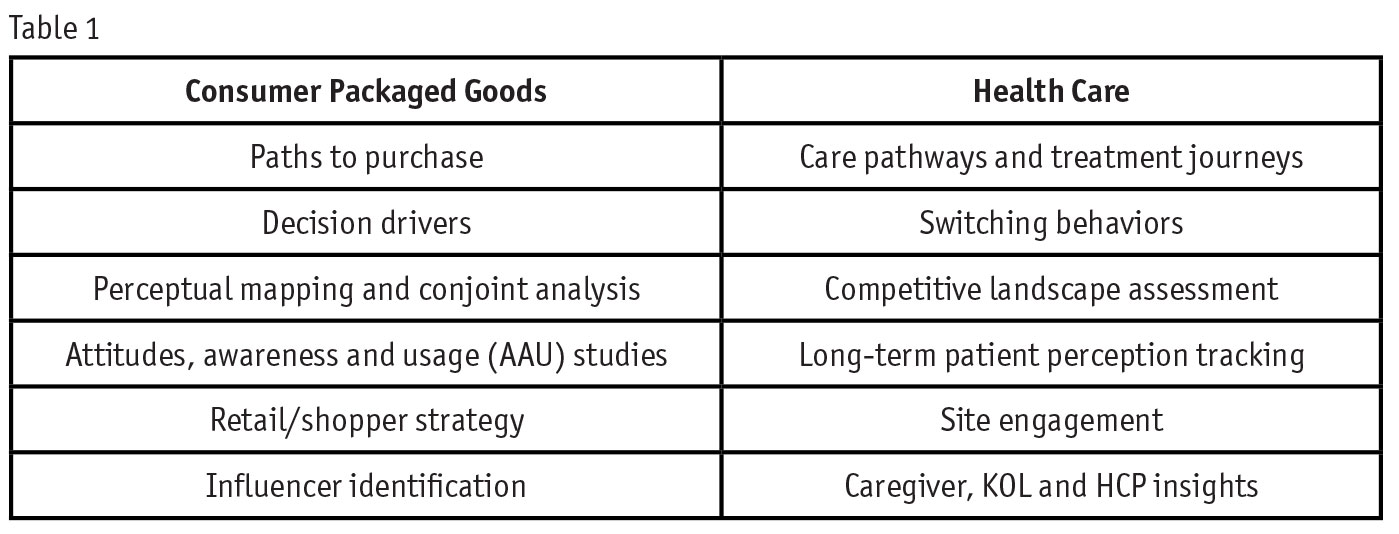More similar than different
Editor's note: Bob Klein is chief insights and experience officer at clinical trial enrollment company Continuum Clinical, Northbrook, Ill. Sid Khaitan is an associate manager of the insights and experience group at Continuum Clinical.
 Let’s say you are a marketer and your target audience is made up of middle-class female Boomers. You would not develop a brand or consider crafting a strategy for how and when to reach these women without fully understanding their motivations, their attitudes and behaviors. But so often in the pharmaceutical industry, that’s exactly what marketers do. This is particularly true on the R&D side of pharma, where getting enough qualified patients to enroll in clinical trials is the primary barrier to getting a drug to market.
Let’s say you are a marketer and your target audience is made up of middle-class female Boomers. You would not develop a brand or consider crafting a strategy for how and when to reach these women without fully understanding their motivations, their attitudes and behaviors. But so often in the pharmaceutical industry, that’s exactly what marketers do. This is particularly true on the R&D side of pharma, where getting enough qualified patients to enroll in clinical trials is the primary barrier to getting a drug to market.
What success would pharma find if it treated potential patients more like traditional consumers, taking cues from market research and brand tactics routinely used in consumer packaged goods (CPG) marketing?
As our notions of “consumer” and “patient” continue to converge into the singular “human” perspective, the inextricable links between CPG and pharma marketing can’t be ignored. Disruption across the pharmaceutical sector has shifted the industry paradigm from blockbuster drugs to generic products, placing people back in the center of the equation.
Accepting that market research across CPG and pharma is indeed more similar than different opens the door to learning from the past, optimizing the present and ideating the future. When we see past the labels, we can unearth a new world of insights by confidently juxtaposing retailers to clinical trial sites, influencers to KOLs, products to medications and consumers to patients.
CPG marketers have been navigating through an era of consumerism for quite some time, building powerful capabilities for analyzing and resonating with their audiences. Market research has been embraced as a core function of the process and a closer examination reveals that many of the areas of learning are also consistent across both industry verticals. Whether you are in the business of understanding the shopper who just strolled into Whole Foods or the patient who just walked into the doctor’s office, your success likely hinges on facilitating trust.
Although the tools and approaches to arrive at trust may appear dissonant between industries, they are fundamentally structured around delivering the right message, at the right time, to the right people and in the right place. The foundation of market research is universally built on optimizing the relevance, placement and impact of marketing strategies in order to foster enduring trust and this is as true for CPG companies as it is for pharma brands. Using market research to achieve a comprehensive understanding of what will resonate with consumers or patients – and where and when to deliver that message – enables us to position ourselves effectively in the eyes of the desired audience, from branding through creative execution.
Establish lasting trust
Our first and perhaps most powerful opportunity to establish lasting trust with our audience – be they shopper consumers or potential clinical trial patients – is in branding. Developing a thoughtful, well-researched brand or study architecture creates efficiencies for subsequent products or related research studies and demonstrates credibility with customers and patients.
The most widely recognized example of a brand architecture is Google, which is structured as a branded house consisting of Google Books, Groups, Videos, News, Maps, Translate and more. On the other hand, Unilever has successfully assembled an incredibly diverse house of brands that includes Dove, Lipton and Knorr. If globally revered organizations have built efficiencies through such consolidation, isn’t it time for pharma to seize the opportunity?
Historically, the R&D side of pharma has maintained a single-study mind-set, tasking procurement teams with finding the best partners for individual studies in an effort to build highly tailored solutions. However, for those conducting multiple trials for the same compound or targeting specific therapeutic areas and conditions, this approach can result in operational redundancies, bottlenecks that cost time and money and, most importantly, isolated studies that leave invaluable brand equity on the table.
Enter the study architecture. By organizing studies under a universal “master brand,” an agile, scalable process is established for categorizing ongoing trials, supporting new trials and improving the recruitability of patients, sites and health care professionals (HCPs).
Imagine a scenario where market research is conducted proactively to inform common study elements such as branding, naming, Web sites and patient/site materials. Instead of duplicating the time and efforts of creative, legal, medical and site teams across individual programs, processes become templated, streamlined and cohesive. As an additional benefit, the seemingly inevitable bottlenecks of legal reviews for trademarks and copyrights, along with regulatory approval, are consolidated, leading to fewer surprises and rapid start-up.
Nevertheless, the true impact of an insight-driven architecture is only realized during implementation. Since study elements are now being created simultaneously and backed by market research, a consistent look and feel is applied across all programs, resulting in identifiable information that resonates with patients, caregivers, HCPs and even investors. As opposed to acting as hollow vessels that simply carry names and logos, brands are transformed into value-drivers that all related studies can tap into. Uniting under a singular communication structure simplifies public relations and corporate content, which in turn materializes into future commercial opportunities with prescribers through therapeutic area dominance.
A well-crafted architecture is a dependable, tested approach that can guide all stakeholders in sorting through the clutter of options and achieving more with less. Drawing analogies between seemingly disparate industries can illuminate the path towards innovation. Expanding our minds to think from a bird’s-eye view and capture best practices that are industry-agnostic provides fundamental value in discovering what works and what doesn’t. As we’ve learned, borrowing the concept of brand architecture from the CPG marketing playbook can engender a level of trust for patients as well, ultimately translating into long-term brand equity for pharma brands.
Once a master brand is established, pharma marketers have many other opportunities to employ traditional consumer market research methods to uncover patient insights that will elevate the established brand, finding patients at the right place and time.
Can become overwhelmed
With a continuously evolving catalog of methodologies to choose from, market researchers can become overwhelmed by the prospect of defining the target in a meaningful way. However, according to Statista, among a group of 1,533 market research professionals surveyed in 2018, 60 percent used digital communities and 43 percent adopted social media analytics by the end of 2017 in order to meet their audience where they are: online.
Social intelligence falls at the intersection of digital communities and social media analytics, offering insights into human behavior as a form of observational research that takes a real-time, big data approach. Among the many merits of social intelligence is its ability to analyze trends surrounding seasons, holidays, campaigns and competitor activities, which immediately suggests applications in CPG marketing. In the world of pharma, an approach like social intelligence can help inform patient journey-mapping, which poses critical implications for protocol design, clinical trial start-up and commercial launch. For example, a patient who only deals with allergies in the summer wouldn’t be receptive to receiving a Zyrtec commercial in the winter.
By leveraging the practice of social intelligence, we can quantify the impact of seasonality. Recently, for example, we were able to gain a big-picture understanding of how seasons affect psoriatic patients in the U.S. As you can see in Figure 1, the frequency of social media mentions peaks during the wintertime due to the intermittent nature of psoriasis flares (10,050 mentions in January compared to 5,927 on average).
Not yet captured the interest
Among more traditional consumer insights tools in CPG is syndicated research, such as GfK MRI’s Survey of the American Consumer. However, the widespread benefits of syndicated studies have not yet captured the interest of health care marketers. But with broad, long-standing studies like the Survey of the American Consumer, which serve as large and updated databases for media consumption, demographics, psychographics and consumer decision-making journeys, you can often glean data surrounding drug-switching behaviors, attitudes towards health care advertising and lifestyle factors for conditions across major therapeutic areas.
For example, a quick crosstab analysis could reveal:
- prevalence data for allergy sufferers among the general population, along with subgroups of those who have used over-the-counter medications for treatment in the past year;
- an estimation of the addressable market for migraine sufferers who use non-prescription headache remedies and pain relievers;
- projections of how many irritable bowel syndrome sufferers also treat constipation and diarrhea;
- profiles of caregivers across conditions, including duties, relationships and demographic data;
- medication adherence, frequency of HCP visits and branded vs. generic drug perceptions that can be segmented for patient populations by age, household income, ethnicity and more.
Arming teams with this information can enrich targeting and messaging for any campaign or study. By knowing the “who, where and how many” of any given patient population or HCP specialization, we can implement program tactics at key moments of aperture, reaching the right people when and where they are the most receptive.
Validated information
Although the aforementioned tools provide valuable insights and directional data prior to the launch of a study or campaign, primary research affords us the opportunity to find fact-based, validated information. As shown in Table 1, the synergies are strikingly analogous across CPG and pharma.

Whether such research is qualitative, quantitative or mixed-method, the expected outcome is the same: to arrive at human insights and inspire strategies that go beyond and deliver more.
Further, consider the value of leveraging primary research to test creative execution. Involving the consumer/patient in concept and messaging evaluation should be a no-brainer, given that they are the intended recipients for such content. Optimizing creative communications to be relevant and original to the target removes any of the guesswork. It has the potential to neutralize the whimsical dilemma famously posed by department store owner John Wanamaker: “Half the money I spend on advertising is wasted; the trouble is, I don’t know which half.”
By understanding that all industries and functions are engineered in the pursuit of solving human-centered problems, it becomes intuitive that “I don’t know what to make for dinner” and “I’m not feeling too well” are actually grounded in the same reality.
